英语语言学讲义Chapter4 Syntax
新篇简明英语语言学-Chapter--Four---Syntax

Chapter Four Syntax 句法学一、定义1. syntax句法学:Syntax is a branch of linguistics that studies the rules that govern the formation of sentences.句法学是一门研究语言的规则,这些规则控制句子的形成。
〔把单词凑在一起形成句子〕二、知识点4.2 Category 范畴Syntactic category 句法类型: Words can be grouped together into a relatively small number of classes, called Syntactic category. 单词可以被组成数量相对较小的类别,称为句法类型。
This classification reflects a variety of factors, (1) including the type of meaning that words express, (2) the type of affies that they take, (3) and the type of structures in which they can occur.这种分类反映出各种不同的因素:〔1〕包括单词所表达的意义的类别,〔2〕它们所带词缀的类别,〔3〕它们所能出现的结构的类别。
word level category词层面类型〔对于句法学而言最核心的类型〕1. Major lexical categories 主要词汇类型〔词性〕:名、动、形、副词N, V, Adj, Adv〔open开放性词类,can add new words〕P43图〔在句子构成中起重要作用〕1〕主要词类又称开放词类,可以不断地出现新词。
在英语,它们主要有四类:名词〔N〕: student linguistics lecture动词〔V〕: like red go形容词〔adj〕: tall lovely red副词〔adv〕: loudly constantly hardP134中2. Minor lexical categories 次要词汇类型〔词性〕:限定、程度、量词、助动、介、代、连、叹Det, Deg, Qual, Aux, Prep, Pron, Conj, Int 〔close封闭性词类, words are fixed不添加新词〕P43图2〕次要词类又称闭合词类。
英语语言学chapter_4_syntax

• Types:
Noun phrase (NP): the pretty girl
Verb phrase ((PP) …
PP
(Adv) P (NP) …
(Note: “ ” means “consist of”; ( ) means “can be omitted”; “…” means other complement options are available)
An NP can consist of a determiner,an N head and a PP compliment.
V. Sentences (The S rule)
• The S rule S NP VP (does not have an internal structure) S
NP
Det
N
The
boy
V found
VP
NP N
Det the book
• Sentences have their own heads, the abstract category inflection (Infl) as their heads, NP (subject) as its specifier, and VP as its compliment.
How to read the three others? My best friend (NP) Always forget something ? Ready for a fight? Mainly about the village?
英语语言学讲义Chapter4exercise

英语语言学讲义Chapter4exerciseChapter 4:SyntaxI. Decide whether each of the following statements is True or False:1. Syntax is a subfield of linguistics that studies the sentence structure of language, including thecombination of morphemes into words.2.Grammatical sentences are formed following a set of syntactic rules.3. Sentences are composed of sequence of words arranged in a simple linear order, with one adding onto another followinga simple arithmetic logic.4.Universally found in the grammars of all human languages, syntactic rules that comprise the system of internalized linguistic knowledge of a language speaker are known as linguistic competence.5. The syntactic rules of any language are finite in number, but there is no limit to the number of sentences native speakers of that language are able to produce and comprehend.6. In a complex sentence, the two clauses hold unequal status, one subordinating the other.7. Constituents that can be substituted for one another without loss of grammaticalitybelong to the same syntactic category.8. Minor lexical categories are open because these categories are not fixed and new members are allowed for.9. In English syntactic analysis, four phrasal categories are commonly recognized and discussed, namely, noun phrase, verb phrase, infinitive phrase, and auxiliary phrase.10. In English the subject usually precedes the verb and the direct object usually follows the verb.11. What is actually internalized in the mind of a native speaker is a complete list of words and phrases rather than grammatical knowledge.12. A noun phrase must contain a noun, but other elements are optional.13. It is believed that phrase structure rules, with the insertion of the lexicon, generate sentences at the level of D-structure.14. WH-movement is obligatory in English which changes a sentence from affirmative to interrogative.II. Fill in each of the following blanks with one word which begins with the letter given:15. A s________ sentence consists of a single clause which contains a subject and a predicate andstands alone as its own sentence.16. A s______ is a structurally independent unit that usually comprises a number of words to forma complete statement, question or command.17. A s______ may be a noun or a noun phrase in a sentence that usually precedes the predicate.18. The part of a sentence which comprises a finite verb or a verb phrase and which says something about the subject is grammatically called p_________.19. A c_________ sentence contains two, or more, clauses, one of which is incorporatedinto the other.20. In the complex sentence, the incorporated or subordinate clause is normally calledan e_______ clause.21. Major lexical categories are o___ categories in the sense that new words areconstantly added.22. A _____ Condition on case assignment states that a case assignor and a caserecipient should stay adjacent to each other.23. P_______ are syntactic options of UG that allow general principles to operate in one way or another and contribute to significant linguistic variations between and among natural languages.24. The theory of C_____condition explains the fact that noun phrases appear onlyin subject and object positions.III. There are four given choices for each statement below. Mark the choice that can best complete the statement:25. A sentence is considered ____ when it does not conform to the grammatical knowledge in themind of native speakers.A. rightB. wrongC. grammaticalD. ungrammatical26. A __________ in the embedded clause refers to the introductory word that introduces theembedded clause.A. coordinatorB. particleC. prepositionD. subordinator27. Phrase structure rules have ____ properties.A. recursiveB. grammaticalC. socialD. functional28. Phrase structure rules allow us to better understand _____________.A. how words and phrases form sentences.B. what constitutes the grammaticality of strings of wordsC. how people produce and recognize possible sentencesD. All of the above.29. Syntactic movement is dictated by rules traditionally called ________.A. transformational rulesB. generative rulesC. phrase structure rulesD. x-bar theory30. The theory of case condition accounts for the fact that __________.A. noun phrases appear only in subject and object positions.B. noun phrases can be used to modify another noun phraseC. noun phrase can be used in adverbial positionsD. noun phrase can be moved to any place if necessary.31. The sentence structure is ________.A. only linearB. Only hierarchicalC. complexD. both linear and hierarchical32. The syntactic rules of any language are ____ in number.A. largeB. smallC. finiteD. infinite33. The ________ rules are the rules that group words and phrases to form grammatical sentences.A. lexicalB. morphologicalC. linguisticD. combinational34._______ rules may change the syntactic representation of a sentence.A. GenerativeB. TransformationalC. X-barD. Phrase structureIV. Define the following terms:35. syntax 36. Sentence 37. coordinate sentence 38. syntactic categories39. grammatical relations 40. linguistic competence 41. transformational rules42. D-structureV. Answer the following questions:43. What are the basic components of a sentence?44. What are the major types of sentences? Illustrate them with examples.45. Are the elements in a sentence linearly structured? Why?46. What are the advantages of using tree diagrams in the analysis of sentence structures?47. What is NP movement. Illustrate it with examples.。
Chapter 4 语言学-Syntax

16
2. The structural approach
The origin: the Swiss linguist Ferdinand de Saussure, “father/founder of modern linguistics” The structural approach regards linguistic units as interrelated with each other in a structure or system.
9
The
relations between classes and functions: Classes and functions determine each other, but not in any one-to-one relation.
A class item can perform several functions. A function can be fulfilled by several classes.
2
Teaching Focus
Four
representative approaches to syntax: 1. The traditional approach 2. The structural approach 3. The generative approach 4. The functional approach
Please
show some examples.
10
1.3
Grammatical categories: a class or group of items which fulfills the same or similar functions in a language. e.g.: Number, gender, case: for nouns and pronouns. Tense, aspect, voice: for verbs
chapter 4 syntax 简明英语语言学 戴炜栋
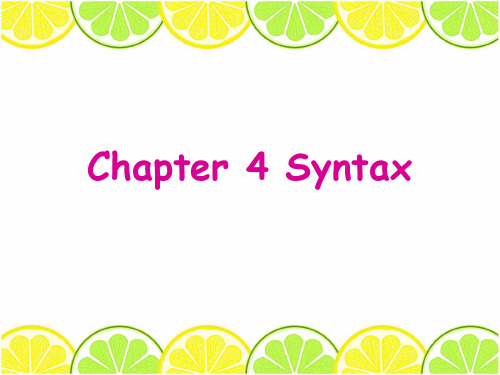
3.3 IC Analysis (直接成分分析法) immediate constituent(直接成分)
Constituent (构成成分) ultimate constituent (最终成分)
IC(直接成分): Can be further segmented until we obtain the smallest grammatical units. UC(最终成分): The smallest grammatical unit obtained through segmentation.
2.2.1 Concord/agreement(一致关系)
A verb is to agree with the subject in person and in number. In English, this rule only affects the verb according to the number of the subject.
This principle refers to the rule that the verb can sometimes agree with the subject according to the notion of number rather than to the actual presence of the grammatical marker for that notion. e.g The government have asked the country to decide by a vote The new military government does not have popular support.
subject subject
语言学第四章chapter4
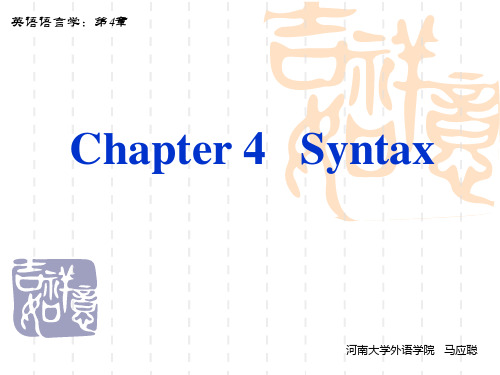
英语语言学:第4章
Adverbs are words that describe or add to the meaning of a verb, an adjective, another adverb, or a sentence, and which answers the questions introduced by how, where, when, etc. carefully, slowly, then, now Prepositions are words used with nouns in phrases providing information about time, place and other connections involving actions and things.
河南大学外语学院 马应聪
英语语言学:第4章
Syntactic rules
(1) a. The hunter fears the cries of the blackbirds. b. The blackbirds fear the cries of the hunter. (2) a. Jack looked up the word. b. Jack looked the word up. (3) *Cries fear the the of hunter blackbirds the. Conclusion: The structure of sentence such as word order can change the meaning. Every sentence is a sequence of words but not every sequence of words is a sentence. Sentence formation has rules, so that we have well/ill formed or (un)grammatical sentences.
英语语言学Chapter 4 Syntax
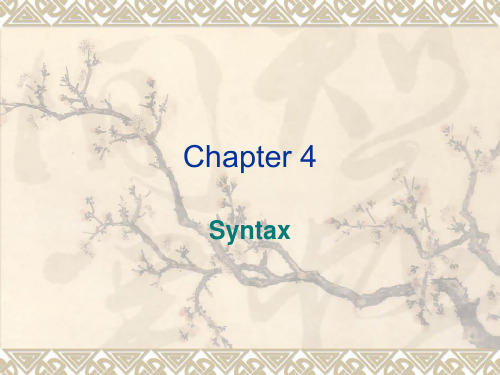
❖ Indocentric construction (内心结构): An endocentric construction is one whose distribution is functionally equivalent to one of its constituents which serves as a head or a center of the whole, for example, NP, VP, AP and AdvP are typical endocentric constructions.
❖ Number: Number is inflectional category basically distinguishing reference to one individual from reference to more than one. It is mostly a category of the noun and pronoun. In English there are two terms of number: singular and plural. But languages like classical Greek and Arabic have a third number: dual, something like the English “both”. And Fijian has a fourth: trial.
First, it must be an animate noun, nouns like book, desk are not possible choices.
Secondly, even within the type of animate nouns, only those which have a semantic component of human are most naturally used with the verb smile.
新编简明英语语言学教程 第二版 戴炜栋4 Syntax
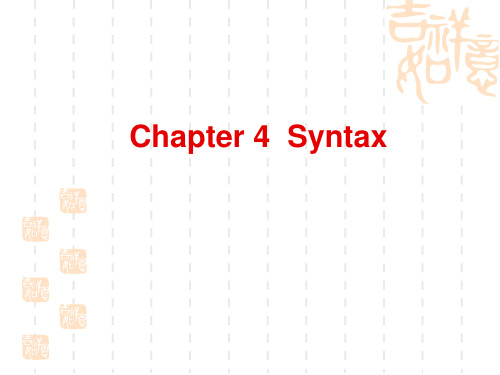
Word-level categories
Major lexical categories: p. 43 N, V, Adj, Prep. Minor Lexical categories: p.43 Det(限定 词), Deg, Qual(修饰语), Auxi, Conj.
The criteria on which categories are determined
Transformational Generative Grammar (TG) Norm. Chomsky, the most influential linguist in 20th century, some important works: (1957) Syntactic Structure; (1965) Aspects of the Theory of Syntax; (1981) Lectures on Government and Binding; (1986) Barriers (1993) A Minimalist Program for Linguistic Theory; (1995) The Minimalist Program; (1998) The Minimalist Inquiry……
Coordination rule
Coordinate structures-----the structures that are formed by joining two or more elements of the same type with the help of a conjunction such as and, or, etc. ----Coordination has four important properties: no limit on the number of coordinated categories before the conjunction; a category at any level can be coordinated; the categories must be of the same type; the category type of the coordinate phrase is identical to the category type of the elements being conjoined.
英语语言学Lecture 4 Syntax
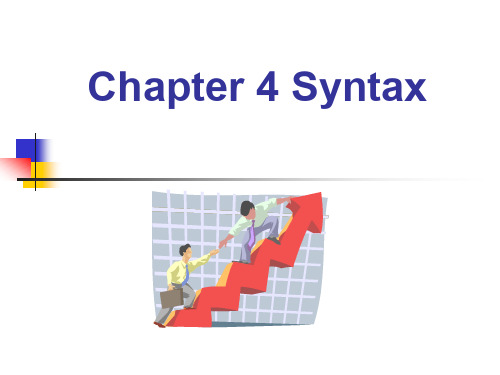
2. Syntactic Relations
It refers to the relation between words in a sentence, which can be studied from both vertical and latitudinal perspectives.
Three types: 1)positional relation, 2)relation of substitutability 3)relations of co-occurrence.
How to do it
1. Brackets ( (Poor) (John) ) ( (ran)( away) )
2. Tree diagrams The girl chased the dog.
Features of IC Analysis
Advantages: Through ICA, the internal structure of a sentence may be demonstrated clearly, and ambiguities will be revealed.
Problems: First, binary divisions of ICA is not
always possible. Second, there exist technical problems for tree diagrams in ICA. Third, there are structural ambiguities which cannot be revealed by IC analysis .
1.1 Definition of Syntax
Syntax refers to the study of the rules governing the way words are combined to form sentences in a language, or simply, the study of the formation of sentences.
简明英语语言学教程Chapter4Syntax

4.2 Categories 1. Word-level categories 3) Three criteria are used to determine a
word’s category.
➢ distribution: what type of elements can co-occur with a certain word. n.: determiner v.: auxiliary adj.: degree word
➢ Is he really that kind? ➢ They can fish here.
4.2 Categories 1. Word-level categories 1) Definition Category: a group of linguistic items (a sentence, a noun phrase, a verb) which fulfill the same or similar functions in a particular language.
Syntactic category: a word (called a word/lexical category) or a phrase (called a phrase category) that performs a particular function in a sentence.
4.2 Categories 1. Word-level categories 2) Types
➢ Major lexical category: (heads) Noun, Verb, Adjective, Preposition
➢ Minor lexical category: Determiner, Degree words, Qualifier, Auxiliary, Conjunction
语言学第四章chapter4

英语语言学:第4章
4.4.2 Immediate constituent analysis
(Bloomfield: 直接成分分析法)
Language is linear and hierarchical. We can analyze language from its largest level to the smallest level, that is from its construction to its constituents by means of substitutability and expansion. The first divisions or cuts of a construction are called immediate constituents and the final cuts as the ultimate constituents.
河南大学外语学院 马应聪
英语语言学:第4章
4.3 The Prescriptive Approach
Definition: An approach taken by some grammarians, mainly in eighteenth-century England, who lay down rules for the correct or “proper” use of English by following Latin.
英语语言学:第4章
Chapter 4 Syntax
河南大学外语学院 马应聪
英语语言学:第4章
outline
4.1 Introduction 4.2 Word Classes 4.3 The Prescriptive Approach 4.4 The Descriptive Approach 4.4.1 Structural analysis 4.4.2 Immediate constituent analysis 4.5 Constituent Structure Grammar 4.6 Transformational Grammar 4.7 Systemic Functional Grammar
语言学_Chapter 4_Syntax

The structural approach regard linguistic units as interrelated with each other in a structure (system), not as isolated bits. This approach to grammar, based on Saussure’s ideas of language, studies the interrelationships between words.
Chapter contents
4.2 how to define each word in the sentence? 4.3, 4.4 How to describe the phrases involved? 4.5 How is the sentence formed?
形式主义对句子结构描述:简单的操作、雅致的 描写、严格、清晰的逻辑。
Syntax refers to the study of the rules governing the way words are combined to form sentences in a language or simply, the study of the formation of sentences.
Structural approach
Generative approach
Traditional approach
Functional approach Rule-governed sentence formation
ห้องสมุดไป่ตู้Word
Sentence
Traditional approach
《简明英语语言学教程》Chapter-4-Syntax
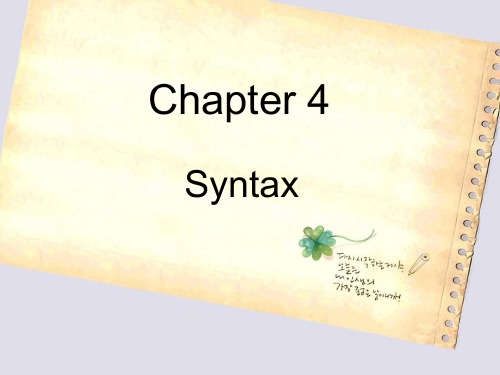
4.2 Categories 1. Word-level categories 2) Types
4.2 Categories 1. Word-level categories 3) Three criteria are used to determine a
word’s category.
➢ distribution: what type of elements can co-occur with a certain word. n.: determiner v.: auxiliary adj.: degree word
➢ Major lexical category: (heads) Noun, Verb, Adjective, Preposition
➢ Minor lexical category: Determiner, Degree words, Qualifier, Auxiliary, Conjunction
4.2 Categories 1. Word-level categories Exercise: Indicate the category of each
word in the following sentences. ➢ The old lady suddenly left.
Det A N Qual V
➢ The car stopped at the end of the road.
《语言学教程》--chapter-4-Syntax
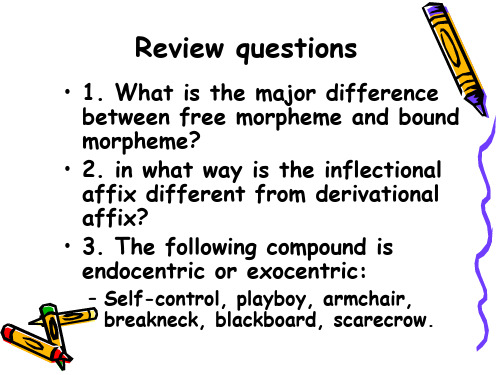
– English belongs to SVO type, though this does not mean that SVO is the only possible word order.
4.1.2 Relation of Substitutability
Constructions
Endocentric
Exocentric
Coordination
Subordination
Endocentric Constructions
Endocentric Constructions
• Definition:
• Endocentric construction is one whose distribution is functionally equivalent to that of one or more of its constituents, i.e., a word or a group of words, which serves as a definable centre or head.
Representative: Saussure •Syntactic relations •Immediate constituent analysis •Endocentric and exocentric constructions
Generative Representative: Chomsky
but it is an economic notation in representing the constituent/phrase structure of a grammatical unit.
英语语言学Chapter 4 Syntax
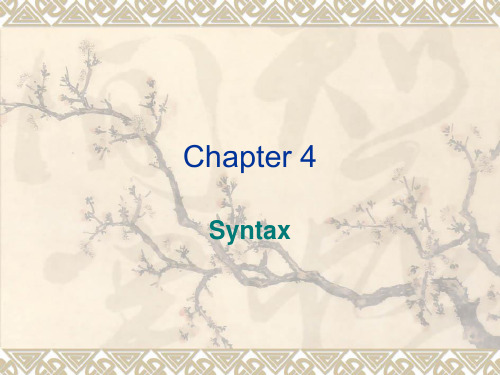
❖ IC analysis of a sentence may be carried out with brackets: ((Poor) (John)) ((ran) (away)). It may also be more easily shown with a tree diagram: Poor John ran away.
❖ Concord: also known as agreement, may be defined as the requirement that the forms of two or more words in a syntactic relationship should agree with each other in terms of some categories.
1. The traditional approach
The classification of words in terms of parts of speech, the identification of functions of words in terms of subject, predicate, etc. 1) Number, gender and case 2) Tense and aspect 3) Concord and government
Chapter 4
Syntax
Syntax
Syntax: The study of the rules governing the
ways words and phrases are combined to form sentences. 1. The traditional approach 2. The structural approach 3. The generative approach 4. The functional approach
自考英语语言学Chapter 4 Syntax

自考英语语言学Chapter 4 Syntax自考英语语言学chapter4syntax第4章语法I.本章大纲二、本章重点句法分析是语言学的一个分支,研究语言的内容和结构。
2022、说明;2022,选择1.syntaxasasystemrules句法规则系统当一个内容与说话者头脑中的语法知识一致时,它被认为是语法化的。
1)语言学中,句法学是和语音学,音系学,形态学,语义学等并列平行的次系统,主要是来分析研究语言的句子结构。
句法是一个由一套数量有限的抽象规则组成的系统,这些抽象规则称为句法规则。
根据句法规则,不同的单词组合在一起,产生符合语法性的句子。
句法学的中心是研究句子的结构成分。
2)句子的语法性意味着句子的合成必须符合母语人士头脑中的语法知识。
生成的句子必须符合语法。
3)单词合成句子,单词和句法规则的数量是有限的,但借助抽象的句法规则,可以将单词合成数量无限的句子。
一方面,说话者要想说出或理解符合语法性的句子,必须遵循句法规则;另一方面,说话者运用句法规则,可以表达或理解从未听说过的句子。
4)任何语言的句法规则必须能够描述和解释所有的母语者认为是规范的句子。
2.sentencestructure句子结构主语是指句子中所指的宾语,如人、物、物、地点、概念等。
谓语是指对句子中对主语进行表述或判断的部分。
通常由限定动词或动词词组构成。
谓语要受到人称、数、时态各语气的限制。
2.2句子类型句子的类型,句子可分为简单句、并列句和复合句三大类。
2.2.1简单句asimplesentenceconsistsofasingleclausewhichcontainsasubjectandapredicateandsta ndsaloneasitsownsentence.(2021填空)指一个句子中含有一个主语和一个谓语。
ACLauseThattached as object and finiteverb,而ametimes stands structurallyalone则被称为afiniteclause。
《语言学》Chapter4Syntax习题兼答案
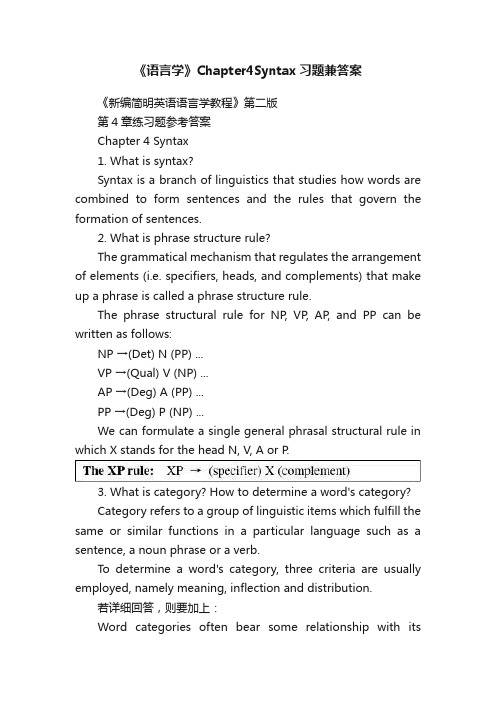
《语言学》Chapter4Syntax习题兼答案《新编简明英语语言学教程》第二版第4章练习题参考答案Chapter 4 Syntax1. What is syntax?Syntax is a branch of linguistics that studies how words are combined to form sentences and the rules that govern the formation of sentences.2. What is phrase structure rule?The grammatical mechanism that regulates the arrangement of elements (i.e. specifiers, heads, and complements) that make up a phrase is called a phrase structure rule.The phrase structural rule for NP, VP, AP, and PP can be written as follows:NP →(Det) N (PP) ...VP →(Qual) V (NP) ...AP →(Deg) A (PP) ...PP →(Deg) P (NP) ...We can formulate a single general phrasal structural rule in which X stands for the head N, V, A or P.3. What is category? How to determine a word's category?Category refers to a group of linguistic items which fulfill the same or similar functions in a particular language such as a sentence, a noun phrase or a verb.To determine a word's category, three criteria are usually employed, namely meaning, inflection and distribution.若详细回答,则要加上:Word categories often bear some relationship with itsmeaning. The meanings associated with nouns and verbs can be elaborated in various ways. The property or attribute of the entities denoted by nouns can be elaborated by adjectives. For example, when we say that pretty lady, we are attributing the property ‘pretty’ to the lady designated by the noun. Similarly, the properties and attributes of the actions, sensations and states designated by verbs can typically be denoted by adverbs. For example, in Jenny left quietly the adverb quietly indicates the manner of Jenny's leaving.The second criterion to determine a word's category is inflection. Words of different categories take different inflections. Such nouns as boy and desk take the plural affix -s. Verbs such as work and help take past tense affix -ed and progressive affix -ing. And adjectives like quiet and clever take comparative affix -er and superlative affix -est. Although inflection is very helpful in determining a word's category, it does not always suffice. Some words do not take inflections. For example, nouns like moisture, fog, do not usually take plural suffix -s and adjectives like frequent, intelligent do not take comparative and superlative affixes -er and -est.The last and more reliable criterion of determining a word's category is its distribution. That is what type of elements can co-occur with a certain word. For example, nouns can typically appear with a determiner like the girl and a card, verbs with an auxiliary such as should stay and will go, andadjectives with a degree word such as very cool and too bright.A word's distributional facts together with information about its meaning and inflectional capabilities help identify its syntactic category.4. What is coordinate structure and what properties does it have?The structure formed by joining two or more elements of the same type with the help of a conjunction is called coordinate structures.It has (或写Conjunction exhibits) four important properties:1) There is no limit on the number of coordinated categories that can appear prior to the conjunction.2) A category at any level (a head or an entire XP) can be coordinated.3) Coordinated categories must be of the same type.4) The category type of the coordinate phrase is identical to the category type of the elements beingconjoined.5. What elements does a phrase contain and what role does each element play?A phrase usually contains the following elements: head, specifier and complement. Sometimes it also contains another kind of element termed modifier.The role each element can play:Head:Head is the word around which a phrase is formed.Specifier:Specifier has both special semantic and syntactic roles. Semantically, it helps to make more precise the meaning of the head. Syntactically, it typically marks a phrase boundary.Complement:Complements are themselves phrases and provide information about entities and locations whose existence is implied by the meaning of the head.Modifier:Modifiers specify optionally expressible properties of the heads.6. What is deep structure and what is surface structure?There are two levels of syntactic structure. The first, formed by the XP rule in accordance with the head's subcategorization properties, is called deep structure(or D-structure). The second, corresponding to the final syntactic form of the sentence which results from appropriate transformations, is called surface structure (or S-structure).(以下几题只作初步的的成分划分,未画树形图, 仅供参考)7. Indicate the category of each word in the following sentences.a) The old lady got off the bus carefully.Det A N V P Det N Advb) The car suddenly crashed onto the river bank.Det N Adv V P Det Nc) The blinding snowstorm might delay the opening of the schools.Det A N Aux V Det N P Det Nd) This cloth feels quite soft.Det N V Deg A8. The following phrases include a head, a complement, anda specifier. Draw the appropriatetree structure for each.a) rich in mineralsXP(AP) →head (rich) A + complement (in minerals) PPb) often read detective storiesXP(VP) →specifier (often) Qual +head (read) V +complement (detective stories) NPc) the argument against the proposalsXP(NP) →specifier (the) Det +head (argument) N +complement (against the proposals) PP d) already above the windowXP(VP) →specifier (already) Deg +head (above) P +complement (the window) NPd) The apple might hit the man.S →NP (The apple) + Infl (might) +VP (hit the man)e) He often reads detective stories.S →NP (He) +VP (often reads detective stories)9. The following sentences contain modifiers of various types. For each sentence, first identify the modifier(s), then draw the tree structures.(斜体的为名词的修饰语,划底线的为动词的修饰语)a) A crippled passenger landed the airplane with extreme caution.b) A huge moon hung in the black sky.c) The man examined his car carefully yesterday.d) A wooden hut near the lake collapsed in the storm.10. The following sentences all contain conjoined categories. Draw a tree structure for each of the sentences.(划底线的为并列的范畴)a) Jim has washed the dirty shirts and pants.b) Helen put on her clothes and went out.c) Mary is fond of literature but tired of statistics.11. The following sentences all contain embedded clauses that function as complements of a verb, an adjective, a preposition or a noun. Draw a tree structure for each sentence.a) You know that I hate war.b) Gerry believes the fact that Anna flunked the English exam.c) Chris was happy that his father bought him a Rolls-Royce.d) The children argued over whether bats had wings.12. Each of the following sentences contains a relative clause. Draw the deep structure and the surface structure trees for each of these sentences.a) The essay that he wrote was excellent.b) Herbert bought a house that she lovedc) The girl whom he adores majors in linguistics.13. The derivations of the following sentences involve the inversion transformation. Give the deep structure and the surface structure of each of these sentences. (斜体的为深层结构,普通字体的为表层结构)a) Would you come tomorrow?you would come tomorrowb) What did Helen bring to the party?Helen brought what to the partyc) Who broke the window?who broke the window。
大学英语新编语言学教程Chapter-4-Syntax
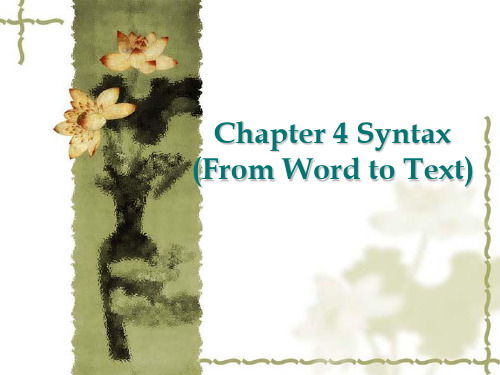
Number
singular plural
Noun
man men
Pronoun
He They
Verb (agreement)
works work
性 (Gender)
❖ Many inflectional languages have three meaning-related gender distinction: masculine, feminine and neuter.
❖ 许多屈折语言里有三种和意义相关的性:阳性、 阴性、中性。
❖ In English gender contrast can be only observed in pronouns and a small number of nouns which shows the biological gender.
❖ The categories of the noun, include number, gender, case and countability;
❖ 名词的范畴包括数、性、格和可数性;
❖ The categories of the verb, for example, person, tense, aspect, mood, voice, etc.
❖ 英语中有被动语态,用“分词”表示。主动 态句子中的施动者在被动态句子中省略,或 用“by短语”
❖ Active voice Jim caught the ball.
❖ Passive voice TБайду номын сангаасe ball was caught.
❖ Passive voice with “by-phrase”
❖ SYNTAX is the study of the rules governing the ways different constituents are combined to form sentences in a language , or the study of the interrelationships between elements in sentence structures.
Chapter 4syntax语言学

Chapter IV. Syntax1 . Traditional approachnumber(singular and plural), gender( masculine, feminine, neuter) and case(in English, 3 cases: nominative/I,he,she, accusative/me, him, her, genitive/my, his, her)tense and aspecttense is time-related, it relates the time of the action, event or state of affairs referred to in the sentence to the time of utterance(the time of utterance being “now”).-past and presentaspect:has to do with whether an action was completed or not, whether it happened once or frequently, whether it occupied a point in time or a stretch of time. English has two co-existent choices of aspect, namely (1).continous denoted by the presence of –ing, I’m writing, and non-continuous, I write. (2). Perfect denoted by the presence of –en. I have written, and noe-perfect, I write.concord and governmentConcord: (agreement) or requirement that the forms of two or more words in a syntactic relationship should agree with each other in terms of some categories.This man. These men. He speaks. They speakGovernment: a type of control over the form of some words byother words in certain syntactic constructions. She gave him the book. She gave the book to him.2. the structural approach: started by the Swiss linguist Ferdinand de Saussure in the 20th century. They regard linguistic units as interrelated with each other in a structure (or system), not as isolated bits.syntagmatic and paradigmatic relationssyntagmatic/horizontal, chain relation组合关系:is a relation between one item and others in a sequence, or between elements which are all present. The words in a syntagmatic relation must meet some syntactic and semantic conditions. (see P120)Structure: the sequence which a sign forms with those it is in a syntagmatic relationparadigmatic relation / vertical, choice(聚合关系/associative): is a relation between elements replaceable with each other at a particular place in a structure, or between one element present and the others absent. .system: the class of signs which are in a paradigmatic relation.the ____ is smilingConstraints:: noun, animate noun, human, in singular(singular human nouns), such as boy, girl, man, woman, student, which are in a paradigmatic relation. They can replace each other without violating syntactic rules.Notes: the constraints are only syntactic, not semantic. immediate constituent analysis:the analysis of a sentence in terms of its immediate constituents – word groups (or phrases), which are in turn analyzed into the immediate constituents of their own, and the process goes on until the ultimate constituents are reached. (stop at the level of word).construction/construct: (in gerneral sense), it refers to the overall process of internal organization of a grammatical unit – how a phrase, a clause or a sentence is constructed out of a set of morphemes by following a set of rules. It can further refer to the syntagmatic result of such a process. (a relationship between constituents: endocentric construction & exocentric construction) In the analysis of a text, construction refers to a token of a constructional type. The girl is giggling is recognized as sub. + Pred. Type, which is realized in a string “ the + girl + is + giggling”. Since construction is composed of several parts (single words, groups of words. Etc.), the small units are know as its immediate constituents. Even the small units themselves can be constructuions of specific types. The girl = nominal phrase (the girl is construction of nominalphrase), whereas the + girl are its constituent.endocentric and exocentric constructionsA construction is a relationship between constituents, whichare divided into two types: endocentric constructions and exocentric constructions.Endocentric construction (headed constucution):is one whose distribution is functionally equivalent, or approaching equivalent, to that of one or more of its constituents, which serves as the center, or head of the whole. (If the total construction [head + modification or modification + head] has the same distributuonal characteristics as the head constituent, it is usually called endocentric construction).For example: they left because they were tired. They left = head. Because…=modifier.Subordinate construction: those in which there is only one head, with the head being dominant and the other constituents dependant.e.g. the student at the back.A subordinating construction contains a subordinator, which is a prep. Particle, or a subordination conjunction such as in, over, to, after, because, and a dependent unit.Coordinate construction: there are more than one head, which are of equal syntactic status, no one is dependant on the other:e.g. boys and girls / John sings but Jack dancesA coordinate construction contains a marker or coordinator andtwo or more independent units (word, phrases or even whole sentences)Exocentric construction: /3. The generative approachIn 1957, the American linguist Chomsky proposed the transformational-generative grammar(TG), thus providing a model for the description of human languages. The goal of TG is to find out a system of rules to account for the linguistic competence of native speakers of a language to form grammatical sentences. It is called TG because it it attempts to do two things:to provide the rules that can be used to generate grammatical sentencesto show how basic sentences can be transformed into either synonymous phrases or more complex sentences4.3.1 deep and surface structuresTG 产生的背景:Because of its insistence on binary divisions and failure to reveal structural ambiguities, certain problems arise in immediate constituent analysis. It is in this context that TG comes into existence.TG 的内容:According to TG, human beings possess twogrammars as part of their linguistic competence.⏹ A phrase structure grammar which consists of the rulesgoverning idealized sentence formation⏹ A transformational grammar, which enables us tomanipulate(use) sentences to produce the full range ofsentence types . TG grammarAs a result , every sentence has a surface structure (post-transformational stage) and deep structure ( a pre-transformational stage).Deep structure:Text book: the abstract representation of the syntactic properties of a construction, i.e. the underlying level of structural relations between its different constituents, such as the relation between the underlying subject and its verb, or a verb and its object.Tragott(1980:141): deep structure shows the basic form of a sentence with all necessary information to derive a well-formed sentence, and to give it a phonological representation and a semantic interpretation. It reveals the underlying structure of a linguistic utterance and specifies the grammatical relations and functions of the syntactic elements, as well as the linguistic meaning of the constituents.Surface structure:Text book: The final stage in the syntactic derivation of a construction, which closely corresponds to the structural organization of a construction people actually produce and receive.Tragott(1980:141): actually produced structure .Bussman (1996:465-466): it is the directly observable actual form of sentences as they are used in communication, and from the perspective of transformational grammar, surface structure is a relatively abstract sentence structure resulting from the application of base rules and transformational rules.Relationship between SS and DS: is that of transformation (Wardhaugh’s, 1997: 118-119) cf: p113-114(杨信彰)4.3.2 the standard theory and after (cf. P135)In 1965, Chomsky published his second important book Aspects of the Theroy of Syntax, in which he introduced some modifications to his 1st model, that is, he added a semantic component to it.Now the language is seen as consisting of three major parts: syntax, semantics and phonology.The base component categories and lexiconContains rules with feature specification for the words to be inserted (cf.P136)Aspects of the Theory of Syntax: more comprehensive and maturecompared with the 1st model, thus is known as the standard theory.4.3.3 government, binding, etc.In 1979: Lectures on Government and Binding.A grammar is now said to have 2 systems.: a rule system(lexicon, syntax, phonetic form component, logical form component), a principle system ( bounding theory, government theory, .θ-theory, binding theory; case theory, control theory) (see figure 6, P140) C-command:refers to the relation between an element and another of the same level and under the same node in a tree diagram, and any others under the latter element as well. (see P142).Condition: An element governs another if the two are under the same node directly, and the former is the head of the construction.Binding theory: (see P144)4.4 The functional approach1. functional sentence perspective (FSP)FSP is a theory of linguistic analysis which refers to an analysis of utterances (or texts) in terms of the information they contain. It is created to describe how information is distributed in sentences, it deals particularly with the effect of the distribution of known information and new information is discourseTheme:that which is known or at least obvious in the given situation and from which the speaker proceeds. (the point ofdeparture话语的出发点)Rheme: What the speaker states about , or in regard to, the starting point of the utterance”(the goal of discourse话语的核心).Mathesius thought that it is natural for the speaker to start from the known to the unknown, and the theme-rheme order is the usual one in unemotional narration (objective order), in emotional narration, it may be possible to reverse the order rheme-theme order (subjective order).Communicative Dynamism(another version of the same analysis, in short CD): The extent to which the sentence element contributes to the development of the communication.This notion is based on the fact that linguistic communication is not a static phenomenon, but a dynamic one. CD is meant to measure the amount of information an element carries in a sentence.2.systemic-functional grammar (has been developed byHalliday)Systemic part (comes from Firth): language elements form into systems.Functional part (comes from Malinowski who attached great importance to the social function of language).Classification of language functions:Karl Buhler: representative, expressive, appellativeRoman Jakobson: referential, emotive, conative, metalinguistic, poetic, phaticHalliday: ideational, interpersonal,textual, which are related to three grammatical systems: transitivity, mood and theme.。
大学英语新编语言学教程Chapter 4 Syntax
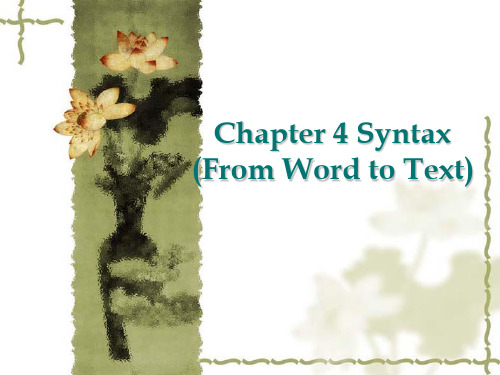
式(Mood)
Mood involves a choice between indicative , imperative and subjunctive forms of the verb on the semantic basis of the factuality. “式”牵涉到在直陈式、祁使式、虚拟式动 词词形间做出选择,这种选择以语义为依据, 视动词所描述的事件真实与否而定。
4.2 Categories
Category in some approaches refers to classes and functions in its narrow sense ,e.g. noun, verb, subject, predicate, noun phrase, verb phrase, etc.
Grammatical Categories
The term “grammatical category” is used by some linguists to refer to word classes. In TG grammatical categories are syntactic units indicated by “category symbols” such as S, NP, VP, Det , A, etc.
体(Aspect)
Aspect deals with how the event described by a verb is viewed. English has two aspect constructions, the perfective and the progressive, realised by “have +ed participle” and “be+-ing participle” respectively.
- 1、下载文档前请自行甄别文档内容的完整性,平台不提供额外的编辑、内容补充、找答案等附加服务。
- 2、"仅部分预览"的文档,不可在线预览部分如存在完整性等问题,可反馈申请退款(可完整预览的文档不适用该条件!)。
- 3、如文档侵犯您的权益,请联系客服反馈,我们会尽快为您处理(人工客服工作时间:9:00-18:30)。
Chapter 4 SyntaxTeaching aims1. Overview of syntax as a system of rules that govern the formation of grammatical sentences.2. Overview the four phrases of syntactic study in the history3. Examine the composition of sentences in terms of category and structure4. Discuss grammatical relations between each noun phrase and the verb in a sentence.5. Introduce IC analysis and five phrases of generative approach.4.1 Introduction to syntaxSyntax consists of a set of abstract rules that allow words to be combined with other words to form grammatical sentences.Grammatical sentences & Syntactic rule1) Sentences are structured according to a particular arrangement of words. Well-arranged sentences are considered grammatical sentences.2) Grammatical sentences are formed following a set of syntactic rulesIntroduction to syntaxAccording to traditional approach grammar is divided into two parts: morphology and syntax.As a major component of grammar,Syntax is a subfield of linguistics that studies the sentence structure of language.Grammatical & ungrammatical sentencesA sentence is considered grammatical when it conforms to the grammatical knowledge in the mind of native speakers.On the other hand, a sentence violates a rule according to which words are organized, then native speakers will judge it to be an impossible sentence of their language.Syntax consists of a set of abstract rules that allow words to be combined with other words to form grammatical sentences.Grammatical sentences & Syntactic rule1) Sentences are structured according to a particular arrangement of words. Well-arranged sentences are considered grammatical sentences.2) Grammatical sentences are formed following a set of syntactic rules4.2 Syntax as s system of rulesDiscussion:Can we make a dictionary of sentences? Why or why not?Universally found in the grammars of all human languages, syntactic rules comprise the system of internalized linguistic knowledge of a language speaker known as linguistic competence.A theory of grammar must provide a complete characterization of linguistic utterances that speakers implicitly consider well-formed, or grammatical, sequences. .Universally found in the grammars of all human languages, syntactic rules comprise the system of internalized linguistic knowledge of a language speaker known as linguistic competence.A theory of grammar must provide a complete characterization of linguistic utterances that speakers implicitly consider well-formed, or grammatical, sequences. .The major goal of linguistics is, then, to show with a consistent and explicit grammatical theory how syntactic rules account for this grammatical knowledgeThe infinite numbers of sentences & Syntactic rule1) For any natural language, a set of syntactic rules are capable of yielding an endless number of sentences in that language.2) That is, the syntactic rules of any language are finite in number, and yet there is no limit to the number of sentences native speakers of that language are able to produce and comprehend.4.3.1 Lexical categories --- Word ClassA language has major and minor lexical categories of a finite set.1) Major lexical categories are open categories in the sense that new words are constantly added.2) Minor lexical categories are closed categories because the number of the lexical items in these categories is fixed and no new members are allowed for.English has four major lexical categories and six minor lexical categories, given below with examples:English Four Major Lexical Categories•Noun (N): student, linguistics, lecture, John•Verb (V): like, read, go•Adjective (Adj): tall, lovely, red•Adverb (Adv): loudly, constantly, hardEnglish has four major lexical categories and six minor lexical categories, given below with examples:•English Six Minor Lexical Categories•Determiner (Det): the, a, this, his•Auxiliary (Aux): can, will, do, be, have•Preposition (Prep): in, at, to, on•Pronoun (Pron): he, she, us, mine•Conjunction (Conj): and, or, but, while•Interjection (Int): oh, ah, eh4.3.2 Phrasal categories --- Phrasal ClassExcept for a very few number, lexical items have certain combinational properties that allow them to combine with words of different categories to form phrases.In English syntactic analysis, four phrasal categories are commonly recognized and discussed, namely, noun phrase (NP), verb phrase (VP) , prepositional phrase (PP), and adjective phrase (AP)The characteristics of phrasal categories1.NP and VP are essential components of a sentence, comprising the two major syntacticcategories, that is, the subject and the predicate of a sentence.2.Notice also that VP in a sentence may contain just a verb, with an optional noun phraseand/or a prepositional phrase;3.NP may contain just a noun, and AP just an adjective.4.NP: a tall man, the student5.VP: hit the student, walk with a stick6.PP: with a stick, in the park7.AP: quite rudeWords and phrases are organized according to the syntactic categories they belong to.•Apart from sentences (S) and clauses (C), a syntactic category usually refers to a word (called a lexical category) or a phrase (called a phrasal category) that performs a particular grammatical function, such as the subject in a sentence.•Constituents that can be substituted for one another without loss of grammaticality belong to the same syntactic category.For example:Which sentences are grammatical sentences?(1) a. The student liked the linguistics lecture.••b. The linguistics lecture liked the student.••c. *Liked the student the linguistics lecture.(2) a. John hit upon an idea.• b. An idea hit upon John.• c. *An hit John upon idea.4.4 Sentence structure (Traditional approach))Discussion:Since syntax deals with the sentence structure of language, we will then ask, among other things, such questions as what constitutes a sentence and what major types of sentences are contained in a language ?The basic components of a sentence1) A sentence is a structurally independent unit that usually comprises a number of words to form a complete statement, question or command.2) Normally a sentence consists of at least a subject and its predicate which contains a finite verb or a verb phrase.This referring expression is grammatically called subject.A subject may be a noun or a noun phrase in a sentence that usually precedes the predicate.The part of a sentence which comprises a finite verb or a verb phrase and which says something about the subject is grammatically called predicate.A finite verb, informally called the main verb of a sentence, expresses existence, action or occurrence which is limited by person, number, tense and mood.e.g. John likes linguistics.•In the above example, "John" is the subject, and "likes linguistics" is the predicate, which is a verb phrase consisting of a finite verb "likes" and its object "linguistics."•Here reference is made to John and something is said about, or predicated of, John.•That is, someone is referred to as "John," and this John "likes linguistics.•Traditionally, three major types of sentences are distinguished, namely, simple sentence, coordinate, or and complex sentence.A. The simple sentenceA simple sentence consists of a single clause which contains a subject and a predicate and stands alone as its own sentence.B. The coordinate sentenceA coordinate sentence contains two clauses joined by a linking word called coordinating conjunction, such as "and," "but," "or."•Traditionally, three major types of sentences are distinguished, namely, simple sentence, coordinate, or and complex sentence.• C. The complex sentenceA complex sentence contains two, or more, clauses, one of which is incorporated into the other. That is, the two clauses in a complex sentence hold unequal status, one subordinating the other.• A. Simple sentencese.g. John reads extensively.Mary decided to take a linguistics class the next semester• B. Coordinate sentencese.g. John is reading a linguistics book, and Mary is preparing for her history exam.John likes linguistics, but Mary is interested in history.• C. The complex sentencee.g. Mary told Jane [that John liked linguistics].Mary asked [John to buy her a linguistics book] .[ That John likes linguistics] puzzles everyone.B. Coordinate sentencese.g. John is reading a linguistics book, and Mary is preparing for her history exam.4.5 The linear and hierarchical structuresof sentenceLanguage is a highly structured system of communication. Sentences are not formed by randomly combining lexical items, but by following a set of syntactic rules that arrange linguistic elements in a particular order to make a string of words not only meaningful but also linearly and hierarchically-structured.(1) The linear word order of a sentenceWhen a sentence is uttered or written down, the words of the sentence are produced one after another in a sequence.•This sequential order of words in a sentence suggests that the structure of a sentence is linear as in the following examplese.g. (1) The student likes the new linguistics professor.(2) John, Mary and Susan went to the linguistics lecture.(2)The hierarchical structure of a sentence•The superficial arrangement of words in a linear sequence does not, however, entail that sentences are simply linearly-structured.•Intuitively, English speakers divide these sentences in the way that obviously follows aparticular hierarchical order, as is shown in (1-2) with different segmentation: •(1) The student // likes / the new linguistics professor.•(2) John, Mary and Susan // went to / the linguistics lecture.This type' of segmentation truthfully reveals the hierarchical nature of sentence structure: sentences are organized with words of the same syntactic category, such as, noun phrase (NP) or verb phrase (VP), grouped together.4.5 Tree diagrams of sentence structureIn a tree diagram, S is the root of the tree, occupying the topmost position, from where it branches into phrasal categories. E.g. NP, VP.In addition to revealing a linear order, a constituent structure tree has a hierarchical structure that groups words into structural constituents and shows the syntactic category of each structural constituent, and consequently is believed to most truthfully illustrate the constituent relationship among linguistic elements.4.5 Concord and government--- Grammatical relation (FY)Concord: It is known as agreement. It can be defined as the requirement that the forms of two or more words in a syntactic relationship should agree with each other in terms of some categories.e.g. this man, these menIn English there are several requirements for “number”, “gender”, and “tense”.Government: It is another type of control over the form of some words by other words in certain syntactic construction. It refers to the relationship in which a word of a certain class determines the form of others in terms of certain category.e.g. She give him a book.The former is governorShe give a book to him.The latter is the governed4.6 The Structural approach--- Proposed by Saussure and American structuralismIn the 20th century, some linguists collect samples of the language they are interested in and attempt to describe the regular structures of the language as it is used, not according to some view of how it should be used.•Structural analysis•Syntagmatic and paradigmatic relations•Immediate constituent analysis•Endocentric and exocentric constructionStructural analysis•Native speakers produce and comprehend sentences according to their internalizedknowledge of the rules, according to which words and phrases are organized.•S --->NP VP•We read the arrow as "consists of," or " is rewritten as," the sentence can be rewritten as, a noun phrase and a verb phrase. "NP structure : NP–(Det) (Adj) N (PP) (S)VP structure : VP–V+ NP+ PP+ (S)Syntagmatic and paradigmatic relationsIn Saussure’s view, language is a system of signs, which consists of two parts: Signified (concept) and Signifier (sound image).•In order to find value of the sign, Saussure identified two types of relations:1) Syntagmatic relation (组合关系) : It is a relation between one item and others in a sequence, or between elements which are all present.2)Paradigmatic relation (聚合关系)/ associative relationIt is a relation holding between elements replaceable with each other at a particular place in a structure, or between one element present and the others absent.Denotation and SenseWords also derive their value from their positions within the language system. The semantic links between elements within the vocabulary system is an aspect of their sense. The relationship between reference and sense is illustrated by Saussure.Each oval is a word, which has its own capacity for reference, but each is also linked to other words in the same language like a cell in a network.Syntagmatic and paradigmatic relationse.g.小王打碎了杯子小猫撞翻了花盆中国人民打败了日本帝国主义和聚合关系是互相有内在联系的两条规则。
